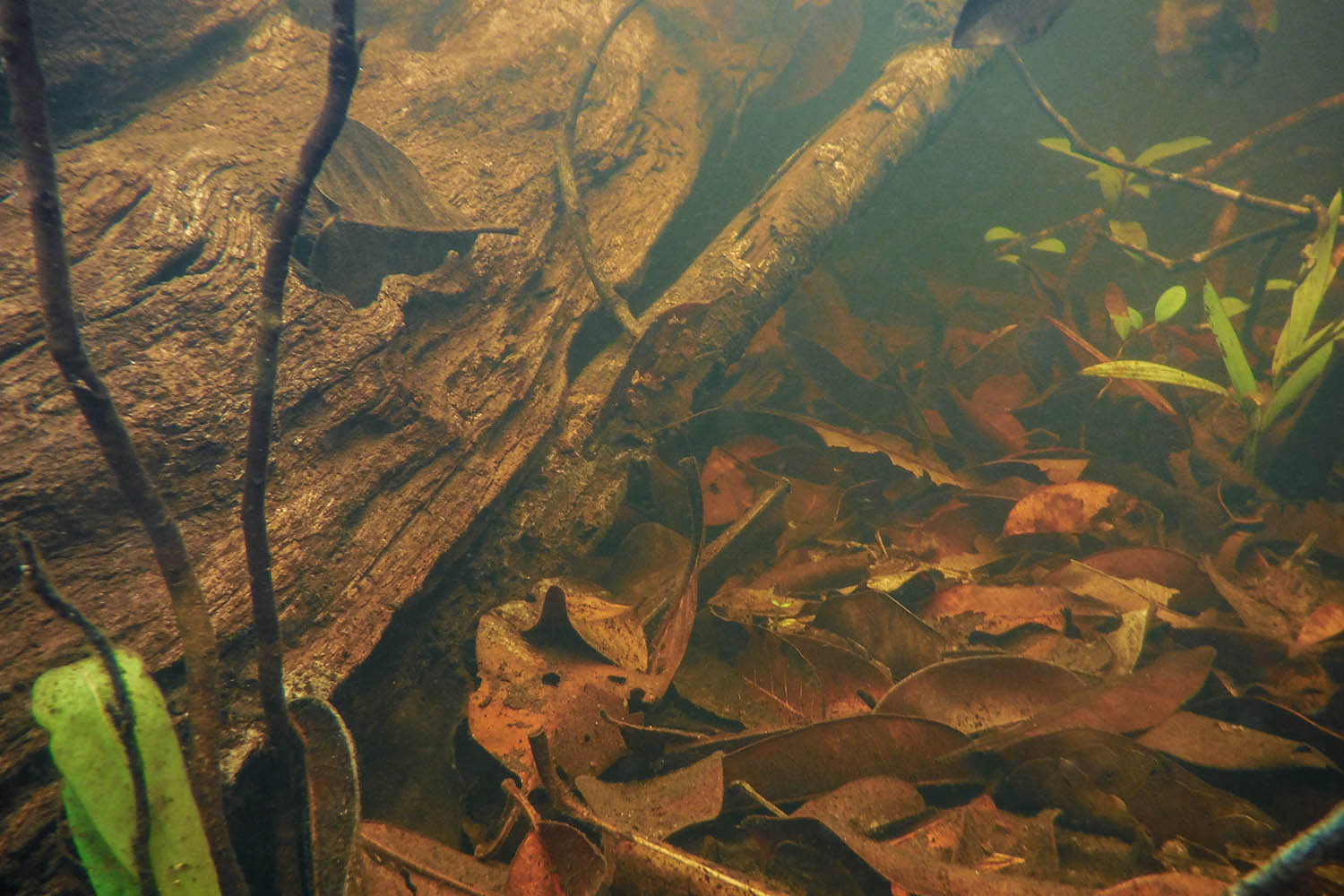
A typical shallow water scene in the middle Rio Negro like this—home to Cardinal Tetras (P. axelrodi) and many other popular aquarium species—served as inspiration for my most recent biotope aquarium
In the most recent (July/August 2017) issue of AMAZONAS, I concluded a two-part exploration into the many unique microhabitats found throughout the middle Rio Negro in Brazil and an in-depth look at how to recreate them in an aquarium. In the years since I first visited this aquarium hobbyist’s paradise in person—getting the chance to observe fish I’ve kept for years in their natural habitat—I’ve spent many hours applying the lessons learned from this (and subsequent visits to the region) to my own home aquariums, attempting to recreate a selection of different biotopes from the region. Some were more successful than others, and as with most aquarium-keeping endeavors, there were lessons to be learned even in the failures. The most recent biotope aquarium I had the opportunity to set up was, in many ways, the culmination of this trial and error approach, and the end result was the closest I’ve come yet to recreating the shallow water habitat of the Cardinal Tetra (among many other species).
While this aquarium (along with several others) is featured in the current issue of AMAZONAS, I wanted to use this shallow water igapó (flooded forest) tank as an example of how to set up a functional, attractive biotope in step-by-step detail from start to finish. With that goal in mind, I documented each step of the setup process, from preparing the substrate to aquascaping on through to the addition of fish for a special web supplement to the print feature Biotope Aquariums of the Rio Negro.
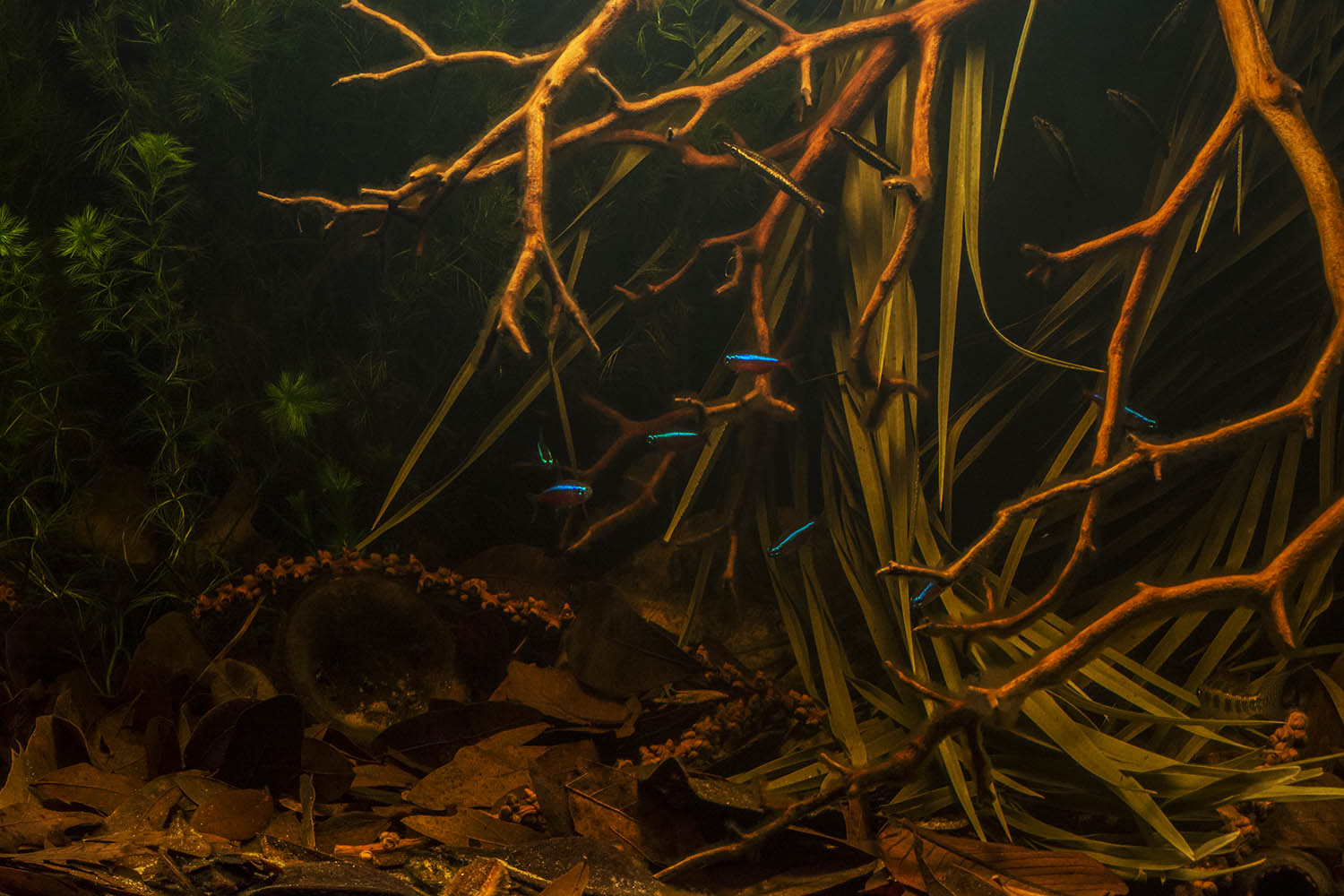
The finished product, stocked with habitat-appropriate fish species, evokes the look and “feel” of the blackwater shallows of the Rio Negro quite effectively
The Tank
While the overall area of shallow flooded forest habitat throughout the Negro is truly vast, covering thousands of square kilometers during the peak high-water season, many of the actual spaces that smaller fish species like tetras inhabit occur on a relatively small scale. Aquatic scenes like a submerged root system, a dense pile of fallen leaves, or the shaded banks of a winding blackwater creek lend themselves well to being recreated in even a smaller aquarium, so with that in mind I chose to use a 15-gallon Fluval Flex all-in-one aquarium as the basis of my shallow igapó biotope. The cube-like dimensions (16 x 15 x 15″) lent themselves well to aquascaping, and the black background (which conceals the filtration and heater behind it in a separate compartment) helped to add a sense of depth that can be difficult to achieve in smaller aquariums. With a relatively low bioload planned for the tank in terms of fish, the built-in filter would be more than adequate, although I removed the activated carbon as it would remove the tannic substances from the water and reduce the heavily-tinted look I was aiming for.
Substrate
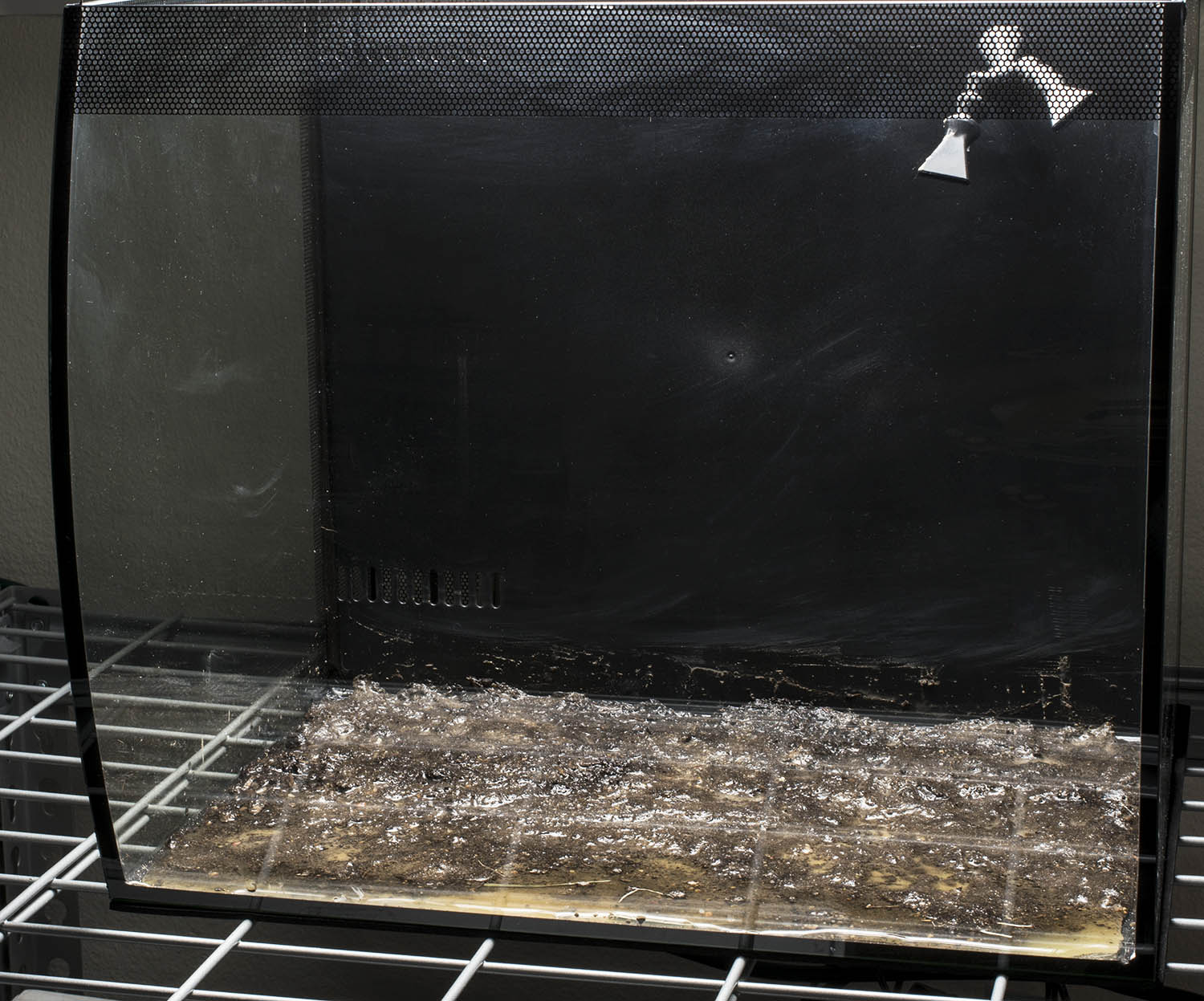
The addition of a layer of rinsed, organic potting mix beneath the substrate was the first step in trying to replicate the detritus- and nutrient-rich substrates found in typical igapó habitat
Through long discussion with fellow blackwater aquarium fanatic Scott Fellman (of Tannin Aquatics), I became interested in the role that substrate can play in a freshwater aquarium even if aquatic plants aren’t intended to be a focal point of the tank. In the Negro, as with other blackwater river systems worldwide, the river bottom—especially in shallow, slow-moving creeks and tributaries—is often a repository for a huge collection of organic matter in various states of decay or decomposition. From submerged branches and logs to fallen fruit, nuts, and seed pods to the ever-present dense carpet of leaf litter, the substrate in most typical igapó habitats is a complex and biologically rich environment—in some cases a microhabitat of its own. With this aquarium, I wanted to experiment a bit in hopes of coming closer to replicating not only the form but the function of this rich source of organics. To do so, I used a technique long known to planted aquarium hobbyists—a “dirted” tank. I took some organic potting mix and over the course of a few weeks rinsed and dried it several times until I had a nice, dense, almost clay-like bottom layer to use in the tank.
For the next layer of substrate, I used my go-to light-colored sand—Sunset Gold by CaribSea—but I wanted to add an additional layer of “enrichment” to leach out tannic acid and other substances over time. For this, I used an array of different botanicals from Tannin Aquatics’ extensive selection, including their “fundo tropical” substrate enhancement media, mariposa pods, banana stem pieces, and their crushed leaf litter mix.
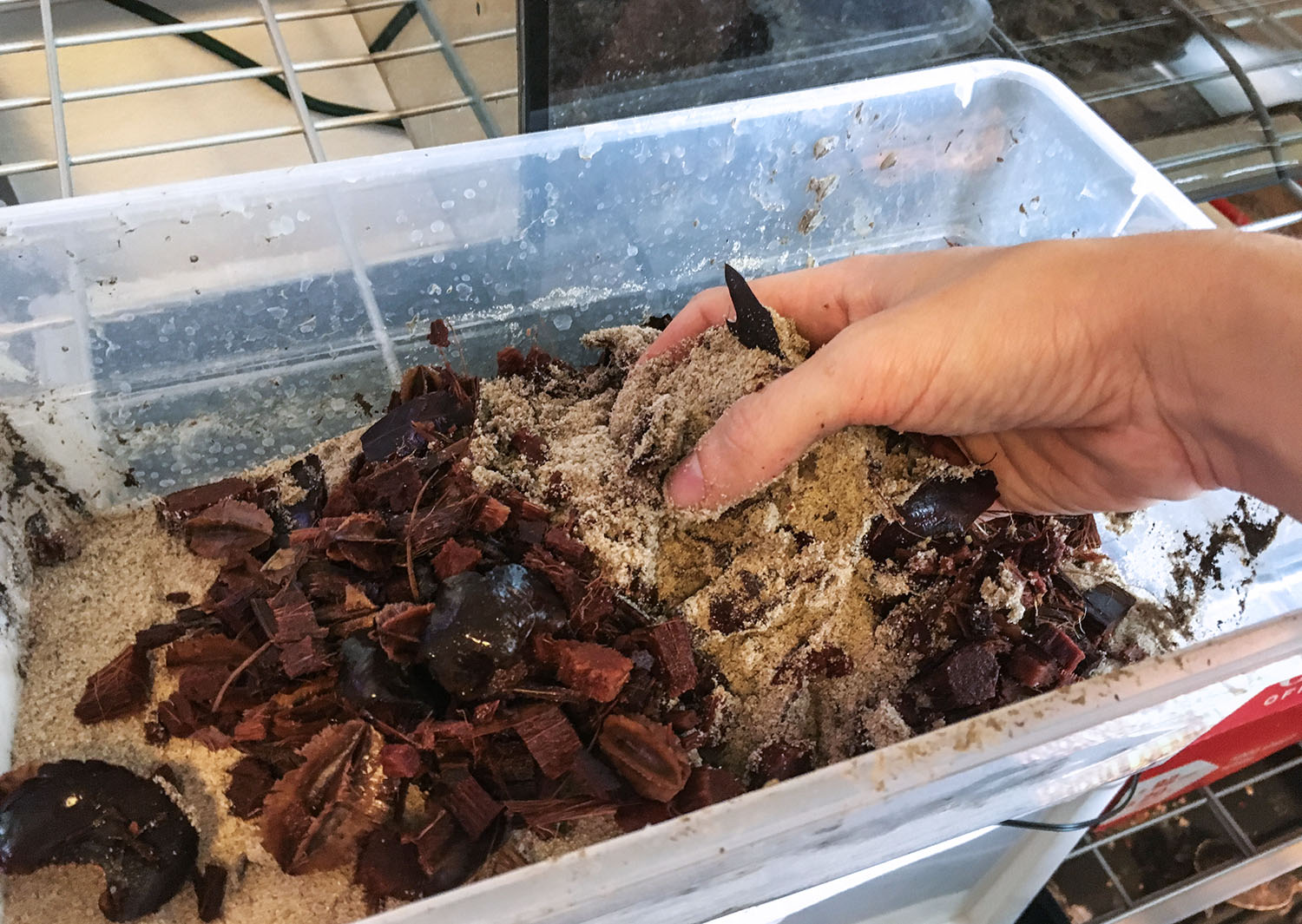
Blending the fine sand and various botanicals to create a substrate that would actively continue to leach tannins into the water for some time
To this, I added a generous handful of Dwarf Magnolia leaves, which I mixed in to the sand by hand after preparation, in this case boiling for nearly an hour. The end result was a nicely heterogeneous mix of fine sand and botanical materials which was then spread out over the bottom layer of dirt, completing the substrate.
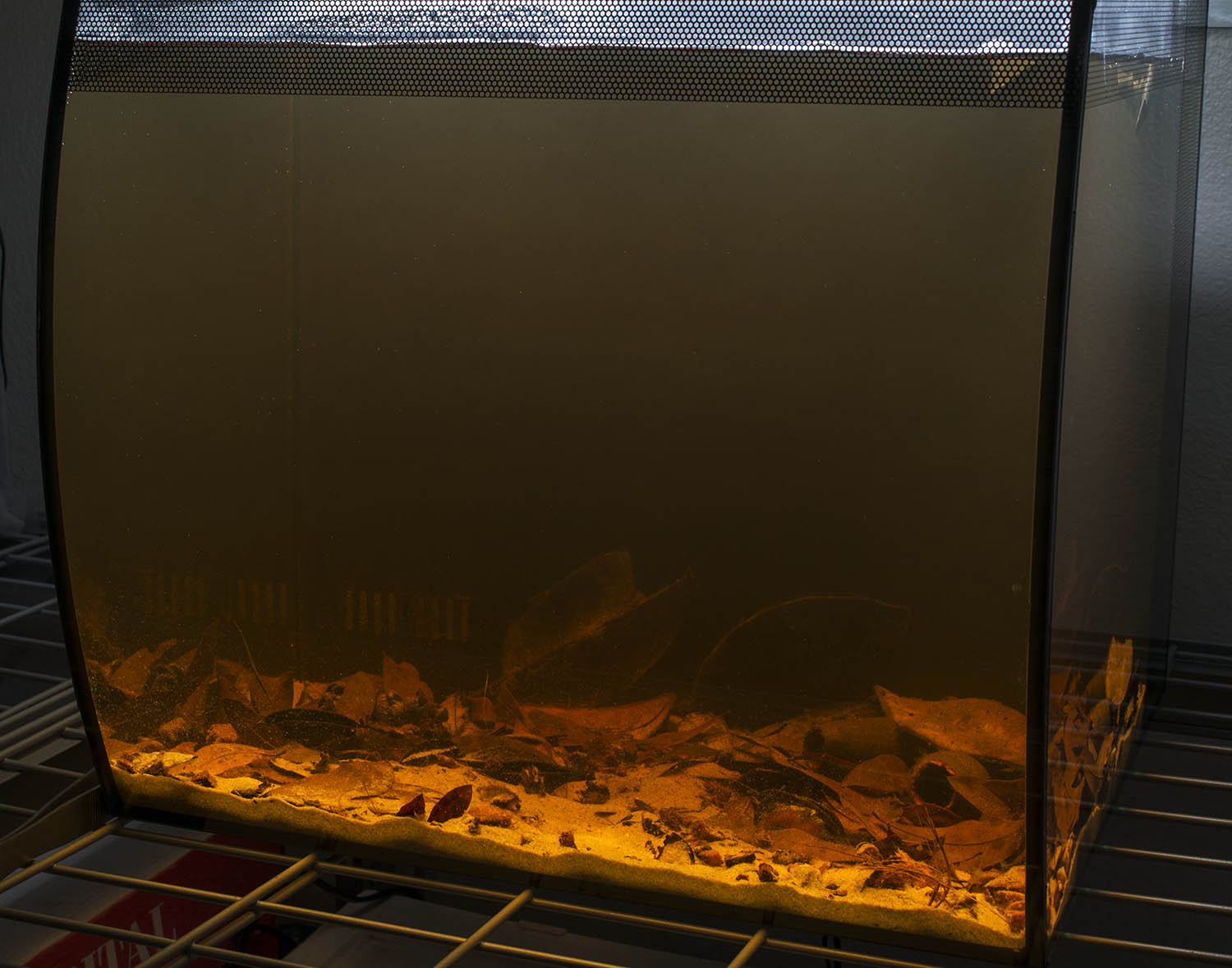
The tank just after being filled with water, already showing a healthy tint due to all the botanicals in the substrate
Aquascaping: A Botanical “Softscape”
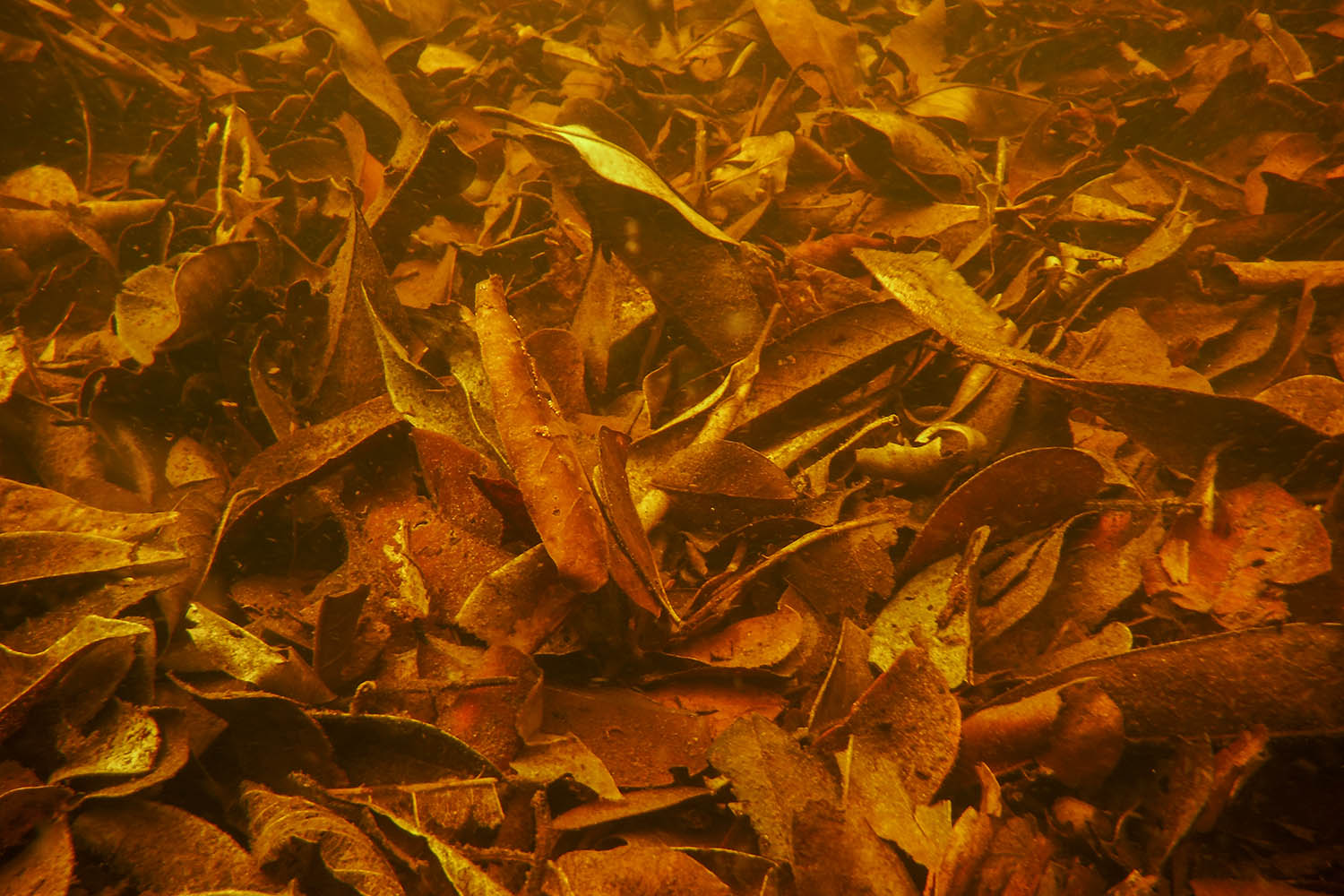
The defining feature of the igapó habitat I was attempting to recreate in this aquarium is not rocks, driftwood, or plants, but rather the dense carpet of leaf litter seen in almost all shallow areas
Unlike the trending style in planted and aquascaped aquariums, which tend to be dominated by elaborate hardscapes and neatly arranged layers of plants, the wild habitat of the Cardinal Tetra tends to be a messy place, and one generally devoid of both rocks and aquatic vegetation. Driftwood is found in abundance, but in the extreme shallows this is often limited to small sticks and twigs, and it is rarely the dominant feature of this habitat type. With that in mind, I set out to create a “softscape” composed largely of botanicals—leaf litter, seed pods, and other accent pieces. Working from the bottom up, I added a dense carpet of dried leaves—primarily Dwarf Magnolia leaves, which are both appropriately-sized for a smaller setup and slow to decay—to replicate what is often the defining feature of shallow blackwater igapó. From there, an assortment of seed pods, which would serve both as accents and as cover for the fish, were placed in the tank.
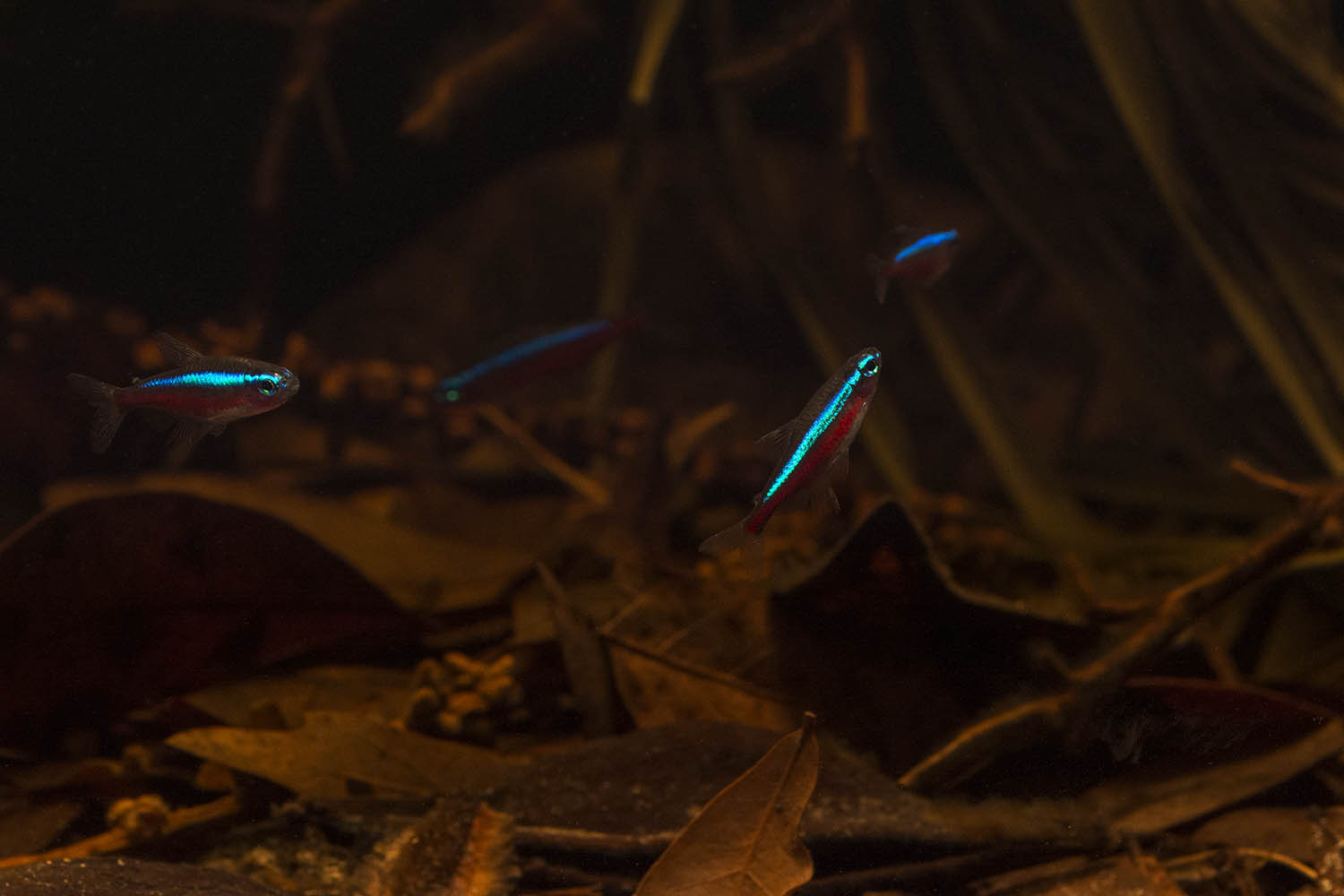
Cardinal Tetras swim in a loose school above the dense leaf litter in what could almost be a scene straight from the wild
With the lower level completed, I added the only real “hard” element of this aquascape—a small branch of manzanita driftwood—which I propped up above the filter output to give the appearance of a fallen branch extending downward into the water. Orienting the driftwood from the surface down (as opposed to substrate-up) not only looks more natural in this setting but also gives the layout an additional dimension, suggesting tangled branches above the water’s surface. After some time playing with the arrangement, it was clear the ‘scape lacked something, especially in the bare back left corner of the aquarium. Reviewing some of my underwater photos and videos from the Rio Negro, I came across inspiration in a flash of green, not a color often seen in that environment. Although vegetation—especially true aquatic plants—are scarce in the acidic, tea-brown waters of the Negro, plants do occasionally make an appearance in the shallows. With that in mind, I took a sprig of Myriophyllum sp. “green” that had been growing unchecked in another tank (like the aquatic weeds they are) and planted it directly into the problem area of the tank. The effect was immediate, and the splash of color the plant added to the otherwise earthy-brown tank balanced the entire aquascape nicely. A large “monkey pot” seed pod placed just in front of the plant, along with some dried fishtail palm stems layered around it, helped blend the disparate elements of the layout together in a subtle but appreciable way.
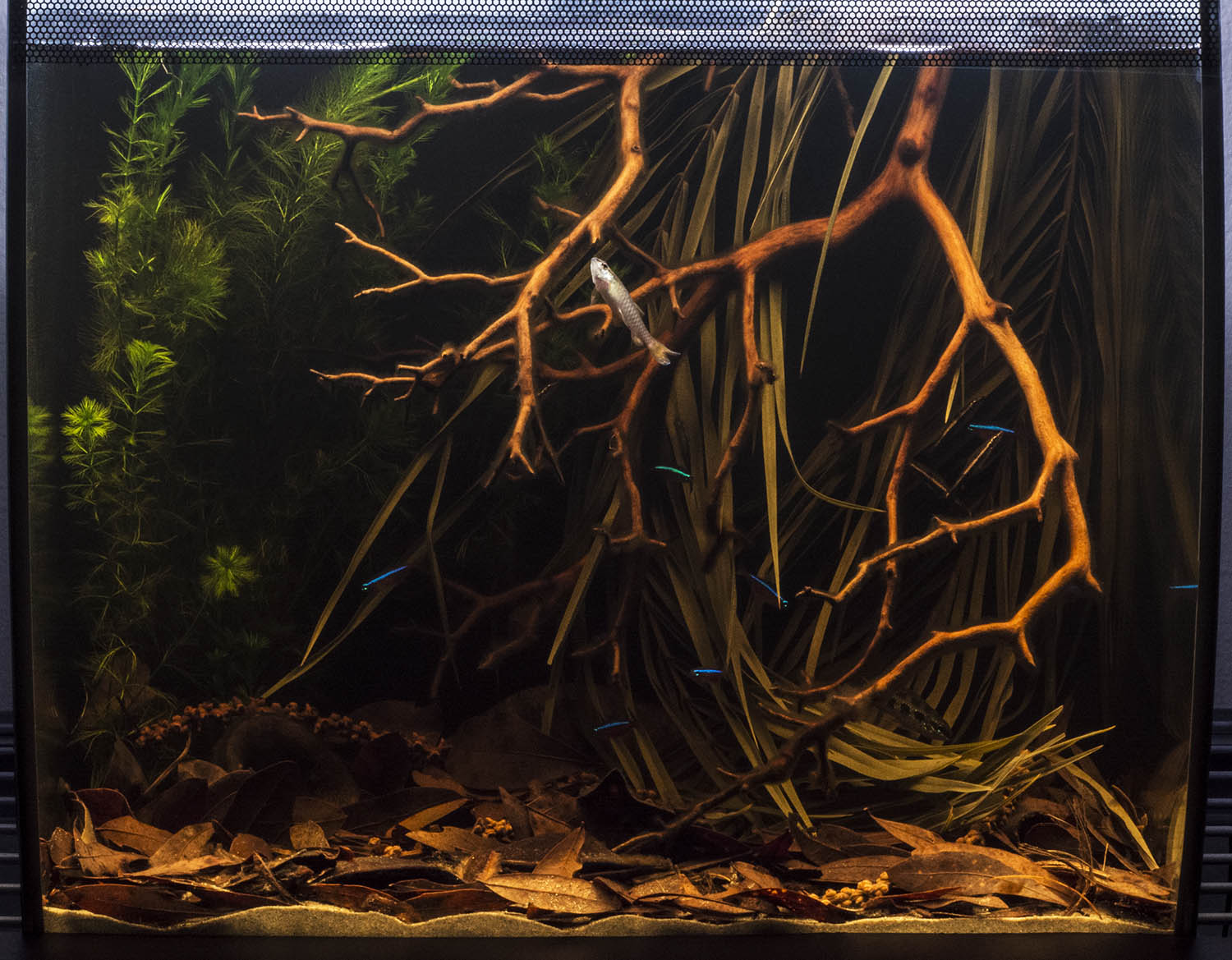
The completed, botanical-heavy aquascape contained all the elements that distinguish typical shallow-water igapó habitat in a natural-looking layout
Intended to be something of a finishing touch, I added a dried palm frond draped behind the manzanita branch. Submerged palm fronds are extremely common in flooded forest habitat throughout the Negro, and I was curious to see how this would look in an aquarium setting. I was pleasantly surprised with the end result: not only did it blend perfectly into the existing aquascape (without being overbearing in the least), it was exactly the final piece that this tank needed to give it that bit of “wow” factor.
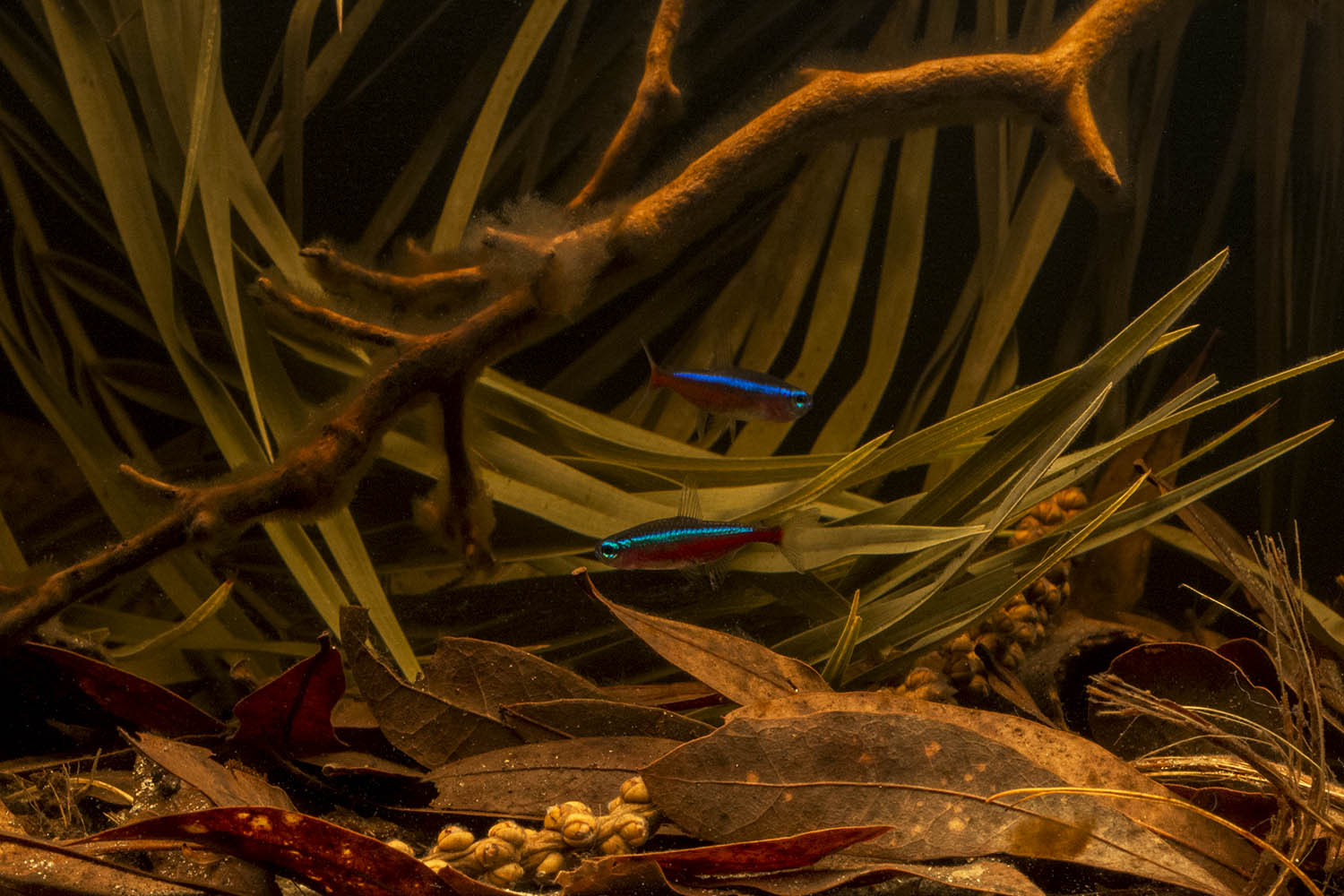
Dried palm fronds, a common sight in shallow flooded forest areas, provided the perfect backdrop for the aquascape and natural cover for the fish
The Fish
Designed around the habitat of the “poster child” of the Rio Negro’s aquarium fish (the Cardinal Tetra), the tank would not be complete without a small school of said fish. A group of seven wild-collected fish formed the centerpiece of the aquarium and replicated how the fish is most often encountered—in smaller groups as opposed to huge shoals. Another commonly-seen fish in the extreme shallows is the Diptail or Eques Pencilfish (Nannostomus eques), one of my favorites of the genus. A pair of Checkerboard Cichlids (Dicrossus maculatus) and a single Pyrrhulina sp. (a close relative of the Splash Tetra) rounded out the tank’s inhabitants. Immediately upon their introduction to the tank, the fish began displaying typical natural behaviors: Checkerboards eagerly shuffling through the leaf litter, Cardinals forming a school hierarchy, and Pencilfish hovering close together near the surface.
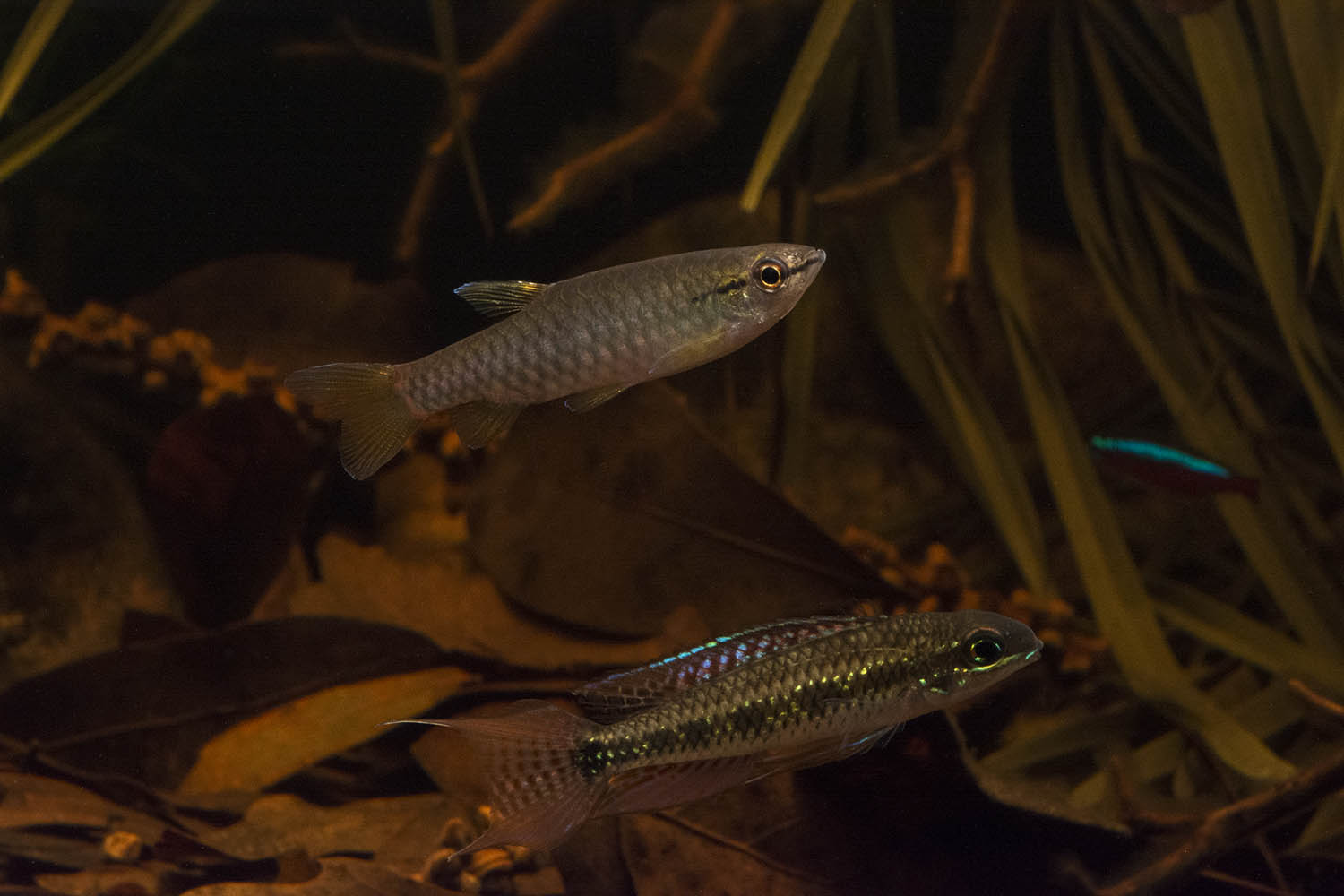
A Pyrrhulina sp. and Checkerboard Cichlid (D. maculatus) added contrast to the small, active school of Cardinal Tetras
Taking a step back to look at the completed aquarium, fish and all, I was extremely pleased with the finished product—by far the closest I’ve come yet to replicating the unique aquatic habitat of the Rio Negro. Between the tinted water, leaf-litter dominated scene, and submerged palm fronds gently swaying in the current of the filter output, this aquarium really stood out as a functional yet aesthetically pleasing replication of a familiar scene from the shallow igapós and blackwater creeks of the middle Negro—wild habitat where many of our most beloved aquarium fish originate.
Learn more about Rio Negro biotopes in the July/August 2017 issue of AMAZONAS Magazine—on sale now!

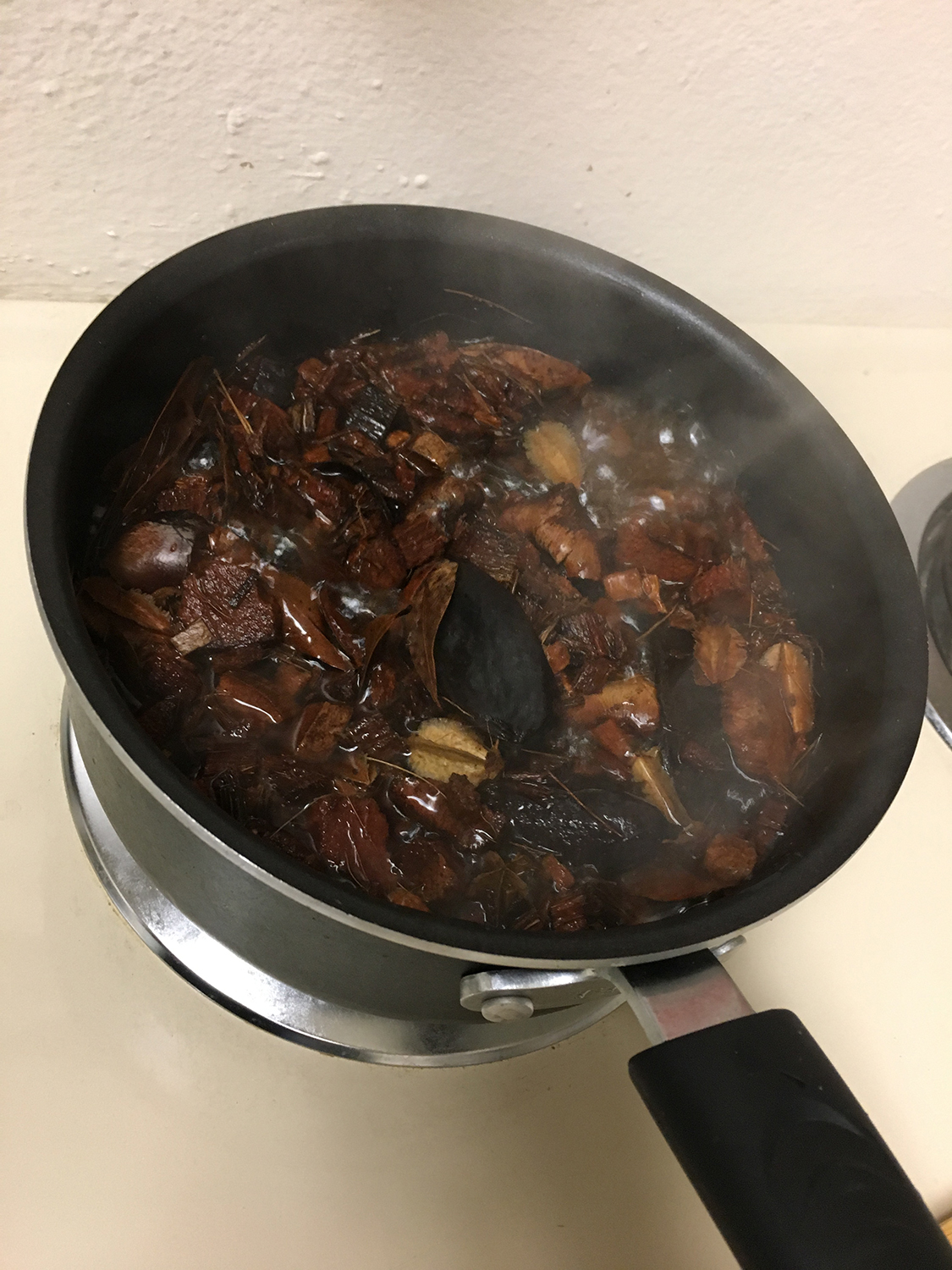





Very nice looking igapo biotope tank. Only one remark. The soil is poor in nutrients, not rich as stated in the article. Due to this fact and the low light, aquatic vegetation in most of these are absent.
Excellent point Jeroen – the soil, and indeed the entire watershed in the Negro is quite nutrient-poor. It is rich, however, in organic and botanical materials and shallow areas are often coated in a dense layer of “mulm”. Using potting soil and a dense layer of botanical materials was intended to mimic this aspect of the habitat.
Can you comment on parameters and long term stability of this set up? 1. water, pH, GH, KH, TDS 2. Plant growth and algae growth?
thanks!
tc
What plants do you speak of & Why would TDS matter in this setup? Why waste his time just because you have to test all of those parameters
Could you please give some information about pH, conuctivity, kH, gH, NO2 and NO3? How long the tank is running? Thank you
Educate yourself on blackwater. So you could ask a more specific question, that isn’t already known if you understand what blackwater is
How will you keep bacterial and/or algal overgrowth from occurring in a tank like this where nutrients will be continually released (feeding and mineralization from decomposition) but not flushed? The Amazon has biotic uptake and flushing to a huge degree. Really love this idea, but afraid of how it will hold up in the long term.
I love this explanation of your design goals and solutions appropriate to the biotope. I accidentally went in that direction in the late 90s with a tank with a lot of mulm, and raised wild discus, tetras, cool catfish, with no problem.I had limited light, with poor options at the time, and used found wood and blackwater tonic as a poor and expensive attempt to keep.the water dark. Discus keepers were horrified, with their bare tanks, but mine bred effusively. Your article inspires me to try actual dirted tanks, sustainable tannin sources, and enough light to grow some weeds. Thanks.
Very nice article!
One correction: the checkerboard cichlid on the picture is Dicrossus filamentosus, not D. maculatus.
How do you maintain tint and water conditions when you do water changes over times?
keep replacing leaves but leaves and wood release tannins over long time so water get color back
hi my project was to create a self sustaining fish tank, hard to say whether is biotope, i places pot soil, sand and organic matter of leaves wood etc. i do not water changes and i do not do any artificial lightening. the tank is small 20l, my my plants are annubias and madagascar lace. i have ~10-20 wild guppies there. there is no algea issue. from time to time i feed guppies otherwise they hunt for tiny food in leaves. the tank has 4 months – we shall see further
I have noticed you don’t monetize your website, don’t waste your traffic, you
can earn extra cash every month. You can use the best adsense alternative for any type
of website (they approve all websites), for more info simply search in gooogle: boorfe’s tips
monetize your website
Thank you. I recently met someone who lives in a Manzanita forest here in California and lets me collect what I want. I have been thinking of a biotope for my neon tetras and beta. My search for inspiration led me here. Thank you so much for sharing!